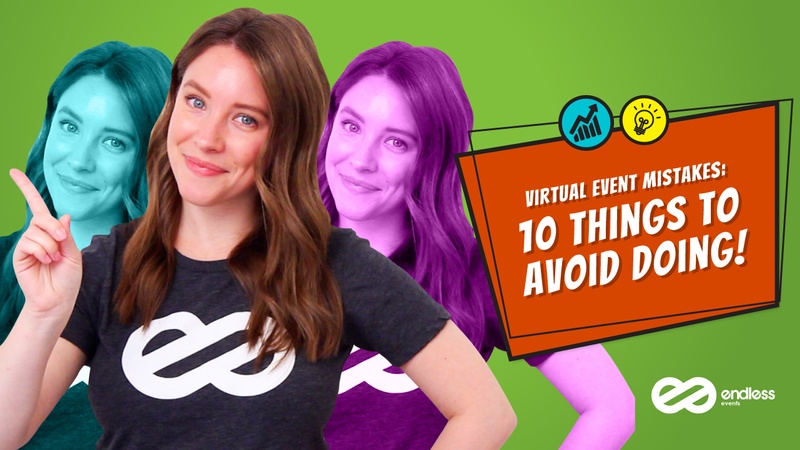
To kick off a new week, we’re going to lay out the most common virtual event mistakes. Even though virtual events are set to become the new normal, not many planners have experience with this paradigm. And that will, invariably, lead to a few mishaps. There are still plenty of misconceptions flying around in regards to virtual events. Because planners and companies aren’t sure which way is North right now, it’s easy to disregard the things that could make or break the virtual experience for everyone involved.
But that’s exactly why we decided to put this list together! We want to help planners and businesses everywhere plan and strategize the best virtual events. And even though we covered some basics where transitioning from in-person is concerned, today we want to touch upon the most common mistakes we see. But most importantly, how you can be mindful of these virtual event mistakes and avoid making them from the get-go. So join us in this quest to learn more about what not to do!
# 1 PowerPoint Heavy Content
Keeping your audience engaged will be one of the hardest tasks associated with putting together a successful virtual event. As we’ve mentioned time and time again, you’re competing with several other distractions. Distractions that aren’t there during an in-person experience and that have the potential to further minimize an already short attention span.
Your content will be pivotal in assuring you hook the attention of the audience. And PowerPoint heavy content is not the way to go! No one wants to look at dense presentation slides for hours on end – that’s a one-way ticket to Boredom Town. Focus on providing educationals yet engaging content with enough balance between words, text, video, and attendee engagement tricks.
#2 Overcomplicating
Failing to take into consideration the technical aptitude of your audience is up there with the most common virtual event mistakes. Just because we live in the 21st century and technology is pretty much ubiquitous, that doesn’t mean every attendee is tech-savvy. Owning a phone and a computer doesn’t equate being a master at all things technology-related!
So depending on your audience, don’t overcomplicate. And the best way to go about this is by making sure that you know your attendees. Who are your personas? How well do they deal with technology? Will they be comfortable with all of the crazy, over the top things you want to include in your virtual event? Or are they not so well versed in the ways of technology? Ask yourself all of these questions before deciding to put together an overcomplicated event that will drive attendees away.
#3 Creating Long Content Days
Heavy PowerPoints shouldn’t be your only concern when it comes to content. Aside from how much you’re presenting to your attendees, you also need to consider for how long you’re making them sit in front of a screen consuming content. Think back to the issue we raised earlier in regards to audience engagement – the same way the audience isn’t interested in very dense sessions, they won’t be interested in very long ones either. Especially not if they have the chance to walk out whenever they want!
Instead of planning a long content day, consider spreading out your virtual event over the course of several days. Instead of a three-day experience with 8 hours each day, do a six-day event with 4 hours a day. This way, your attendees won’t feel exhausted after the first time; on the contrary, they’ll feel eager to show up the following days.
#4 Choosing The Wrong Presenters
Let’s assume you took the right steps and managed to avoid mistakes #1 and #3 and you not only put together extremely interesting content, but you also went out of your way to plan a longer event with shorter days in order to maximize engagement. Well, all of those efforts will be for nothing if you fail to choose the right presenters. As a matter of fact, speakers are such an important part of virtual events, we strongly recommend you choose people with previous remote experience.
Here’s why: if you want the audience to have a good incentive to stay and attend the event until the end, you have to keep the ball rolling. A good presenter will be a digital native that can juggle the chatrooms, the Q&A sessions, and the camera, all the while rocking the room and keeping attendees happy and pleading for more. Plus, you want a charismatic and magnetic figure that makes it nearly impossible for people to walk out! Choosing a presenter who isn’t familiar with the format or can’t keep the attention of people for too long can have pretty bad consequences. At the very least, go with someone who is willing to undergo some training from people who’ve done it before.
# 5 Choosing The Wrong Platform
One of the first things you’ll have to juggle when planning a virtual event is the choice of platform. And now more than ever, this seems like a daunting task, due in no small park to the amount of choice that exists. There are dozens of platforms out there that promise the best services and the best support for your endeavor – but how can you know?
We’ve already discussed why we don’t believe in all-in-one platforms. But even if you agree, that still leaves a lot of potential candidates to choose from. Making a comprehensive list of what you’re looking for in a platform and then doing the research to look for the best fit is a good strategy. The right platform will depend from planner to planner and from event to event, which is why defining the goals of your virtual event is an important first step to take.
# 6 Wrong Sponsors
Sponsorships will stay alive and well in virtual events. Just because the industry is going remote, that doesn’t mean the end of one of the most trustworthy sources of revenue. On the contrary; the digital world offers endless new possibilities for planners to promote their sponsors and for sponsors to get potential leads from the virtual experience.
But one of the biggest virtual event mistakes lies in the choice of sponsors. Again, one of the keys to a successful virtual event is keeping the audience engaged. And that means minimizing distractions. If you choose sponsors that have nothing to do with the industry or topic that surrounds the event, you’re promoting the distractions instead of taming them. Be mindful of the choices you make here because it’s not as obvious as other mistakes on this list.
#7 Insisting On Poster Sessions
Poster sessions have been a staple at scientific conferences in the world of engineering and medicine. And while this works beautifully in-person and allows for people in the field to present and discuss their findings, it’s not an ideal format to translate into virtual events. Many people believe this is still possible and think it will elevate the experience.
Here’s the thing, though: posters aren’t engaging content. And not only that, but they’re complex to execute within the realms of a virtual event. Insisting on a poster session would not only mean throwing away all the work put into engaging content and charismatic speakers but also demand a lot of resources, both financial and labor. Jeopardizing budget, hours, and content in the name of poster sessions is one of the biggest virtual event mistakes one can make, and completely avoidable.
# 8 Not Rehearsing
Rehearsing is not optional…rehearsal is not optional…rehearsal is not optional! This is something you have to repeat to yourself, your team, and your speaker dozens and dozens of times in case someone tries to argue with the logic. But in all seriousness, neglecting to rehearse before the event actually takes place is irresponsible and just an overall bad practice. Would you forego testing the lights, sound, computers, videos, etc before an in-person event? Probably not.
The same should apply to your virtual event, especially if it’s new, unexplored ground for you. Make sure everything around you is exactly how it’s going to be on the actual day, and try to anticipate everything that could potentially go wrong. Flag the issues that you find and get them fixed ASAP so that everything goes smoothly when the times comes to make things happen.
#9 Neglecting Attendees Post-Event
Attendee engagement doesn’t end once the event is over! Curiously enough, one of the most common virtual event mistakes lies in the fact that planners and businesses seem to forget about their audience once they logout. But if you want to know the extent of the success of your event, and wish for people to come back for more once you put together another one, engagement efforts have to be extended to the post-event timeline.
Administer surveys and ask them for their opinions. What did they enjoy most? What could have been done better? Ask questions that will give you important and actionable feedback. Upload the recording of the event to social media channels and your website so that attendees can go back and watch it as many times as they want. There are a lot of things you can do in the name of engagements even after the event is finished!
# 10 Not Hiring A Specialized Production Company
It goes without saying that working with the best is one step further towards success. Because truth is, virtual events are still relatively new. Event though webinars have been around for a while, they aren’t anywhere near as popular as in-person events. And the odds that you have all the knowledge to put this together by yourself are slim. But that’s okay!
This is why Virtual Event Production companies exist. They have the knowledge surrounding technologies, platforms, and best-practices that you need. And if there’s a chance of working with people that have the resources you lack, don’t discard it. You can chat with us at any time and find out if Endless can help you. Remember that surrounding yourself with experts keeps you from incurring in perfectly avoidable virtual event mistakes!












